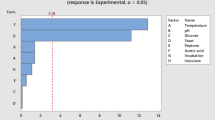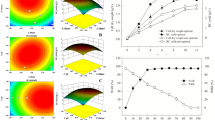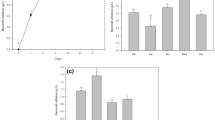Abstract
Bacterial cellulose (BC) is a biopolymer mainly produced by acetic acid bacteria (AAB) that has several applications in the medical, pharmaceutical, and food industries. As other living organisms, AAB require sources of chemical elements and nutrients, which are essential for their multiplication and metabolite production. So, the knowledge of the nutritional needs of microorganisms that have important industrial applications is necessary for the nutrients to be supplied in the appropriate form and amount. Considering that the choice of different nutrients as nitrogen source can result in different metabolic effects, this work aimed to verify the effects of amino acid supplementation in the culture media for BC production by an AAB strain (Komagataeibacter intermedius V-05). For this, nineteen amino acids were tested, selected, and optimized through a Plackett and Burman factorial design and central composite design to determine the optimal concentrations of each required amino acid. Membranes produced under optimal conditions were characterized in relation to chemical structure and properties by X-ray diffraction (XRD), thermogravimetric analysis (TGA), differential scanning calorimetry (DSC), infrared spectroscopy (FT-IR), and hydrophilic properties. Three amino acids had a significant positive effect and were required: aspartic acid (1.5 g L−1), phenylalanine (1.5 g L−1), and serine (3.0 g L−1). Conversely, all sulfur and positively charged amino acids had a negative effect and reduced the production yield. After optimization and validation steps, a production level of 3.02 g L−1 was achieved. Membranes produced from optimized media by this strain presented lower crystallinity index but greater thermal and hydrophilic properties than those produced from standard HS medium.





Similar content being viewed by others
Data Availability
All data supporting the conclusions of this study are included within the article and its supplementary materials file.
References
Chen, S. Q., Meldrum, O. W., Liao, Q., Li, Z., Cao, X., Guo, L., Zhang, S., Zhu, J., & Li, L. (2021). The influence of alkaline treatment on the mechanical and structural properties of bacterial cellulose. Carbohydrate Polymers, 271, 118431.
Islam, M. U., Ullah, M. W., Khan, S., Shah, N., & Park, J. K. (2017). Strategies for cost-effective and enhanced production of bacterial cellulose. International Journal of Biological Macromolecules, 102, 1166–1173.
Gomes, R. J., Borges, M. F., Rosa, M. F., Castro-Gómez, R. J. H., & Spinosa, W. A. (2018). Acetic acid bacteria in the food industry: Systematics, characteristics and applications. Food Technology and Biotechnology, 56, 139–151.
Lin, D., Liu, Z., Shen, R., Chen, S., & Yang, X. (2020). Bacterial cellulose in food industry: Current research and future prospects. International Journal of Biological Macromolecules, 158, 1007–1019.
Wang, J., Tavakoli, J., & Tang, Y. (2019). Bacterial cellulose production, properties and applications with different culture methods–A review. Carbohydrate Polymers, 219, 63–76.
Lahiri, D., Nag, M., Dutta, B., Dey, A., Sarkar, T., Pati, S., Edinur, H. A., Kari, Z. A., Noor, N. H. M., & Ray, R. R. (2021). Bacterial cellulose: Production, characterization and application as antimicrobial agent. International Journal of Molecular Sciences, 22, 12984.
Jawan, R., Abbasiliasi, S., Tan, J. S., Mustafa, S., Halim, M., & Ariff, A. B. (2020). Influence of culture conditions and medium compositions on the production of bacteriocin-like inhibitory substances by Lactococcus lactis Gh1. Microorganisms, 8, 1454.
Dinarvand, M., Rezaee, M., & Foroughi, M. (2017). Optimizing culture conditions for production of intra and extracellular inulinase and invertase from Aspergillus niger ATCC 20611 by response surface methodology (RSM). Brazilian Journal of Microbiology, 48, 427–441.
Kumar, S., Pakshirajan, K., & Dasu, V. V. (2009). Development of medium for enhanced production of glutaminase-free L-asparaginase from Pectobacterium carotovorum MTCC 1428. Applied Microbiology and Biotechnology, 84, 477–486.
Ferreira, S. L., Caires, A. O., Borges, T. D. S., Lima, A. M., Silva, L. O., & Santos, W. N. (2017). Robustness evaluation in analytical methods optimized using experimental designs. Microchemical Journal, 131, 163–169.
Wang, J., & Wan, W. (2009). Experimental design methods for fermentative hydrogen production: A review. International Journal of Hydrogen Energy, 34, 235–244.
Myers, R. H., Khuri, A. I., & Carter, W. H. (1989). Response surface methodology: 1966–l988. Technometrics, 31, 137–157.
Pereira, L. M. S., Milan, T. M., & Tapia-Blácido, D. R. (2021). Using response surface methodology (RSM) to optimize 2G bioethanol production: A review. Biomass and Bioenergy, 151, 106166.
Yolmeh, M., & Jafari, S. M. (2017). Applications of response surface methodology in the food industry processes. Food and Bioprocess Technology, 10, 413–433.
Qiu, J., Song, F., Qiu, Y., Li, X., & Guan, X. (2013). Optimization of the medium composition of a biphasic production system for mycelial growth and spore production of Aschersonia placenta using response surface methodology. Journal of Invertebrate Pathology, 112, 108–115.
Luthra, U., Singh, N., Tripathi, A., Vora, S., & Bhosle, V. (2015). Media optimization for lovastatin production by statistical approach using Aspergillus terreus by submerged fermentation. Journal of Medical Science and Clinical Research, 3, 4520–4528.
Boudrahem, F., Ziani, S., & Aissani-Benissad, F. (2019). Application of response surface methodology based on central composite design for optimization of yellow bezacryl sorption on shoe soles waste. Environmental Progress & Sustainable Energy, 38, S412–S421.
Grahovac, J., Grahovac, M., Dodić, J., Bajić, B., & Balaž, J. (2014). Optimization of cultivation medium for enhanced production of antifungal metabolites by Streptomyces hygroscopicus. Crop Protection, 65, 143–152.
Singh, V., Haque, S., Niwas, R., Srivastava, A., Pasupuleti, M., & Tripathi, C. (2017). Strategies for fermentation medium optimization: An in-depth review. Frontiers in Microbiology, 7, 2087.
Nurfarahin, A. H., Mohamed, M. S., & Phang, L. Y. (2018). Culture medium development for microbial-derived surfactants production—An overview. Molecules, 23, 1049.
Keshk, S. M., & Sameshima, K. (2005). Evaluation of different carbon sources for bacterial cellulose production. African Journal of Biotechnology, 4, 478–482.
Mikkelsen, D., Flanagan, B. M., Dykes, G. A., & Gidley, M. J. (2009). Influence of different carbon sources on bacterial cellulose production by Gluconacetobacter xylinus strain ATCC 53524. Journal of Applied Microbiology, 107, 576–583.
Gomes, R. J., Faria-Tischer, P. C. S., Tischer, C. A., Constantino, L. V., Rosa, M. F., Chideroli, R. T., Pereira, U. P., & Spinosa, W. A. (2021). Komagataeibacter intermedius V-05: An acetic acid bacterium isolated from vinegar industry, with high capacity for bacterial cellulose production in soybean molasses medium. Food Technology and Biotechnology, 59, 432–442.
Rajput, K. N., Patel, K. C., & Trivedi, U. B. (2016). Screening and selection of medium components for cyclodextrin glucanotransferase production by new alkaliphile Microbacterium terrae KNR 9 using Plackett-Burman design. Biotechnology Research International, 2016, 3584807.
Du, L., Liu, S., Hao, G., Zhang, L., Zhou, M., Bao, Y., Ding, B., Sun, Q., & Zhang, G. (2021). Preparation and release profiles in vitro/vivo of galantamine pamoate loaded poly (Lactideco-Glycolide)(PLGA) microspheres. Frontiers in Pharmacology, 11, 2392.
Zhang, Q., Li, Y., Xu, F., Zheng, M., Xi, X., Zhang, X., & Han, C. (2017). Optimization of submerged fermentation medium for matrine production by Aspergillus terreus, an endophytic fungus harboring seeds of Sophora flavescens, using response surface methodology. Mycobiology, 45, 90–96.
Núñez, D., Cáceres, R., Ide, W., Varaprasad, K., & Oyarzún, P. (2020). An ecofriendly nanocomposite of bacterial cellulose and hydroxyapatite efficiently removes lead from water. International Journal of Biological Macromolecules, 165, 2711–2720.
Kačuráková, M., Smith, A. C., Gidley, M. J., & Wilson, R. H. (2002). Molecular interactions in bacterial cellulose composites studied by 1D FT-IR and dynamic 2D FT-IR spectroscopy. Carbohydrate Research, 337, 1145–1153.
Segal, L. G. J. M. A., Creely, J. J., Martin, A. E., Jr., & Conrad, C. M. (1959). An empirical method for estimating the degree of crystallinity of native cellulose using the X-ray diffractometer. Textile Research Journal, 29, 786–794.
Barud, H., Ribeiro, C., Crespi, M., Martines, M., Dexpert-Ghys, J., Marques, R., Messaddeq, Y., & Ribeiro, S. (2007). Thermal characterization of bacterial cellulose–phosphate composite membranes. Journal of Thermal Analysis and Calorimetry, 87, 815–818.
Feng, X., Ullah, N., Wang, X., Sun, X., Li, C., Bai, Y., Chen, L., & Li, Z. (2015). Characterization of bacterial cellulose by Gluconacetobacter hansenii CGMCC 3917. Journal of Food Science, 80, E2217–E2227.
Teixeira, S. R. Z., Reis, E. M. D., Apati, G. P., Meier, M. M., Nogueira, A. L., Garcia, M. C. F., Schneider, A. L. S., Pezzin, A. P. T., & Porto, L. M. (2019). Biosynthesis and functionalization of bacterial cellulose membranes with cerium nitrate and silver nanoparticles. Materials Research, 22, e20190054.
Chandrasekaran, P. T., Bari, N. K., & Sinha, S. (2017). Enhanced bacterial cellulose production from Gluconobacter xylinus using super optimal broth. Cellulose, 24, 4367–4381.
Kohlmeier, M. (2015). Nutrient metabolism: Structures, functions, and genes (2nd ed.). Academic Press.
Wu, G. (2009). Amino acids: Metabolism, functions, and nutrition. Amino Acids, 37, 1–17.
Leonardi, R., & Jackowski, S. (2007). Biosynthesis of pantothenic acid and coenzyme A. EcoSal Plus, 2, 1–17.
Spry, C., Kirk, K., & Saliba, K. J. (2008). Coenzyme A biosynthesis: An antimicrobial drug target. FEMS Microbiology Reviews, 32, 56–106.
Tortora, G. J., Funke, B. R., & Case, C. L. (2019). Microbiology: An introduction (13th ed.). Pearson Education.
Sahm, F., Oezen, I., Opitz, C. A., Radlwimmer, B., Von Deimling, A., Ahrendt, T., Adams, S., Bode, H. B., Guillemin, G. J., Wick, W., & Platten, M. (2013). The endogenous tryptophan metabolite and NAD+ precursor quinolinic acid confers resistance of gliomas to oxidative stress. Cancer Research, 73, 3225–3234.
VanLinden, M. R., Skoge, R. H., & Ziegler, M. (2015). Discovery, metabolism and functions of NAD and NADP. Biochem., 37, 9–13.
Zhu, F., Peña, M., & Bennett, G. N. (2021). Metabolic engineering of Escherichia coli for quinolinic acid production by assembling L-aspartate oxidase and quinolinate synthase as an enzyme complex. Metabolic Engineering, 67, 164–172.
Pereira, L., Girardi, J. P., & Bakovic, M. (2012). Forms, crosstalks, and the role of phospholipid biosynthesis in autophagy. International Journal of Cell Biology, 2012, 931956.
Heo, M. S., & Son, H. J. (2002). Development of an optimized, simple chemically defined medium for bacterial cellulose production by Acetobacter sp. A9 in shaking cultures. Biotechnology and Applied Biochemistry, 36, 41–45.
Son, H. J., Kim, H. G., Kim, K. K., Kim, H. S., Kim, Y. G., & Lee, S. J. (2003). Increased production of bacterial cellulose by Acetobacter sp. V6 in synthetic media under shaking culture conditions. Bioresource Technology, 86, 215–219.
Matsuoka, M., Tsuchida, T., Matsushita, K., Adachi, O., & Yoshinaga, F. (1996). A synthetic medium for bacterial cellulose production by Acetobacter xylinum subsp. sucrofermentans. Bioscience, Biotechnology, and Biochemistry, 60, 575–579.
Kalam, M. A., Humayun, M., Parvez, N., Yadav, S., Garg, A., Amin, S., Sultana, Y., & Ali, A. (2007). Release kinetics of modified pharmaceutical dosage forms: A review. Continental Journal of Pharmaceutical Sciences, 1, 30–35.
Figueiredo Filho, D. B., Júnior, J. A. S., & Rocha, E. C. (2011). What is R2 all about? Leviathan, 3, 60–68.
Lahiri, D., Nag, M., Mukherjee, D., Garai, S., Banerjee, R., & Ray, R. R. (2021). Recent trends in approaches for optimization of process parameters for the production of microbial cellulase from wastes. Journal of Environmental Sustainability, 4, 273–284.
Lahiri, D., Nag, M., Dutta, B., Sarkar, T., & Ray, R. R. (2021). Artificial neural network and response surface methodology-mediated optimization of bacteriocin production by Rhizobium leguminosarum. Iranian Journal of Science and Technology, Transactions A: Science, 45, 1509–1517.
Lahiri, D., Nag, M., Sarkar, T., Dutta, B., & Ray, R. R. (2021). Antibiofilm activity of α-amylase from Bacillus subtilis and prediction of the optimized conditions for biofilm removal by response surface methodology (RSM) and artificial neural network (ANN). Applied Biochemistry and Biotechnology, 193, 1853–1872.
Peng, S., Zheng, Y., Wu, J., Wu, Y., Ma, Y., Song, W., & Xi, T. (2012). Preparation and characterization of degradable oxidized bacterial cellulose reacted with nitrogen dioxide. Polymer Bulletin, 68, 415–423.
Güzel, M., & Akpınar, Ö. (2020). Preparation and characterization of bacterial cellulose produced from fruit and vegetable peels by Komagataeibacter hansenii GA2016. International Journal of Biological Macromolecules, 162, 1597–1604.
Li, X., Li, J., Gong, J., Kuang, Y., Mo, L., & Song, T. (2018). Cellulose nanocrystals (CNCs) with different crystalline allomorph for oil in water Pickering emulsions. Carbohydrate Polymers, 183, 303–310.
Barud, H. S., Araújo Júnior, A. M., Santos, D. B., Assunção, R. M., Meireles, C. S., Cerqueira, D. A., Rodrigues Filho, G., Ribeiro, C. A., Messaddeq, Y., & Ribeiro, S. J. (2008). Thermal behavior of cellulose acetate produced from homogeneous acetylation of bacterial cellulose. Thermochimica Acta, 471, 61–69.
George, J., Ramana, K. V., Sabapathy, S. N., Jagannath, J. H., & Bawa, A. S. (2005). Characterization of chemically treated bacterial (Acetobacter xylinum) biopolymer: Some thermo-mechanical properties. International Journal of Biological Macromolecules, 37, 189–194.
Vasconcelos, N. F., Feitosa, J. P. A., Gama, F. M. P., Morais, J. P. S., Andrade, F. K., Souza, M. D. S. M., & Rosa, M. F. (2017). Bacterial cellulose nanocrystals produced under different hydrolysis conditions: Properties and morphological features. Carbohydrate Polymers, 155, 425–431.
Souza, E. F., Furtado, M. R., Carvalho, C. W., Freitas-Silva, O., & Gottschalk, L. M. (2020). Production and characterization of Gluconacetobacter xylinus bacterial cellulose using cashew apple juice and soybean molasses. International Journal of Biological Macromolecules, 146, 285–289.
Rojo, Ú. M., Rossi, E., Cerrutti, P., Errea, M. I., & Foresti, M. L. (2021). Preparation of water insoluble carboxymethylated bacterial cellulose with maximum lead retention capacity. Journal of Polymer Research, 28, 1–7.
Molina-Ramírez, C., Cañas-Gutiérrez, A., Castro, C., Zuluaga, R., & Gañán, P. (2020). Effect of production process scale-up on the characteristics and properties of bacterial nanocellulose obtained from overripe Banana culture medium. Carbohydrate Polymers, 240, 116341.
Ul-Islam, M., Khan, T., & Park, J. K. (2012). Water holding and release properties of bacterial cellulose obtained by in situ and ex situ modification. Carbohydrate Polymers, 88, 596–603.
Huang, H. C., Chen, L. C., Lin, S. B., Hsu, C. P., & Chen, H. H. (2010). In situ modification of bacterial cellulose network structure by adding interfering substances during fermentation. Bioresource Technology, 101, 6084–6091.
Lin, S. B., Hsu, C. P., Chen, L. C., & Chen, H. H. (2009). Adding enzymatically modified gelatin to enhance the rehydration abilities and mechanical properties of bacterial cellulose. Food Hydrocoll., 23, 2195–2203.
Eslahi, N., Mahmoodi, A., Mahmoudi, N., Zandi, N., & Simchi, A. (2020). Processing and properties of nanofibrous bacterial cellulose-containing polymer composites: A review of recent advances for biomedical applications. Polymer Reviews, 60, 144–170.
Mohite, B. V., & Patil, S. V. (2014). Physical, structural, mechanical and thermal characterization of bacterial cellulose by G. hansenii NCIM 2529. Carbohydrate Polymers, 106, 132–141.
Bandyopadhyay, S., Saha, N., & Sáha, P. (2018). Characterization of bacterial cellulose produced using media containing waste apple juice. Applied Biochemistry and Microbiology, 54, 649–657.
Acknowledgements
We would like to thank “Laboratório de Espectroscopia (ESPEC)” and “Laboratório de Difração de Raios X (LabDRX)” of the State University of Londrina for providing equipment and assistance in the chemical characterization analyses.
Funding
We thank “Conselho Nacional de Desenvolvimento Científico e Tecnológico (CNPq)” for providing scholarship to Rodrigo J. Gomes (grant number: 142380/2017–2) and research fellowship to Wilma A. Spinosa (grant number: 307846/2020–2).
Author information
Authors and Affiliations
Contributions
Rodrigo J. Gomes: methodology, formal analysis and investigation, writing (original draft preparation); Elza I. Ida: writing (review and editing); Wilma A. Spinosa: conceptualization, funding acquisition, supervision.
Corresponding author
Ethics declarations
Ethics Approval
This article does not contain any studies with human participants or animals performed by any of the authors.
Consent to Participate
Not applicable.
Consent for Publication
Not applicable.
Competing Interests
The authors declare no competing interests.
Additional information
Publisher's Note
Springer Nature remains neutral with regard to jurisdictional claims in published maps and institutional affiliations.
Supplementary Information
Below is the link to the electronic supplementary material.
Tables S1 and S2 can be obtained as supplementary material in the online version of this article.
Rights and permissions
About this article
Cite this article
Gomes, R.J., Ida, E.I. & Spinosa, W.A. Nutritional Supplementation with Amino Acids on Bacterial Cellulose Production by Komagataeibacter intermedius: Effect Analysis and Application of Response Surface Methodology. Appl Biochem Biotechnol 194, 5017–5036 (2022). https://doi.org/10.1007/s12010-022-04013-4
Accepted:
Published:
Issue Date:
DOI: https://doi.org/10.1007/s12010-022-04013-4




